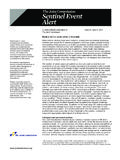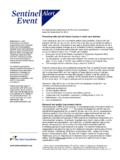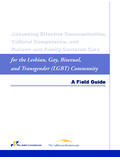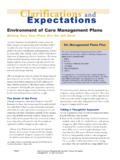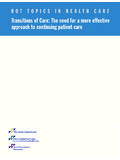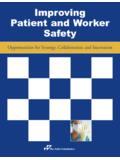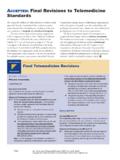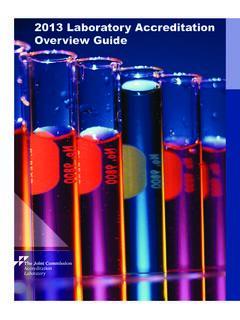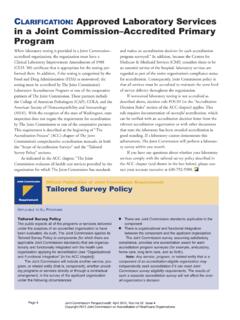Transcription of National Patient Safety Goals® Effective January 2022 for ...
1 National Patient Safety Goals Effective January 2022 for the Ambulatory Health Care ProgramGoal 1 Improve the accuracy of Patient at least two Patient identifiers when providing care, treatment , or for errors occur in virtually all stages of diagnosis and treatment . The intent for this goal is two-fold: first, to reliably identify the individual as the person for whom the service or treatment is intended; second, to match the service or treatment to that individual. Acceptable identifiers may be the individual s name, an assigned identification number, telephone number, or other person-specific (s) of Performance for at least two Patient identifiers when administering medications, blood, or blood components; when collecting blood samples and other specimens for clinical testing; and when providing treatments or procedures.
2 The Patient 's room number or physical location is not used as an identifier.(See also , EPs 7, 10; , EP 10) containers used for blood and other specimens in the presence of the Patient .(See also , EP 10)Goal 3 Improve the Safety of using all medications, medication containers, and other solutions on and off the sterile field in perioperative and other procedural settings. Note: Medication containers include syringes, medicine cups, and for or other solutions in unlabeled containers are unidentifiable. Errors, sometimes tragic, have resulted from medications and other solutions removed from their original containers and placed into unlabeled containers. This unsafe practice neglects basic principles of safe medication management, yet it is routine in many labeling of all medications, medication containers, and other solutions is a risk-reduction activity consistent with safe medication management.
3 This practice addresses a recognized risk point in the administration of medications in perioperative and other procedural settings. Labels for medications and medication containers are also addressed at Standard (s) of Performance for perioperative and other procedural settings both on and off the sterile field, label medications and solutions that are not immediately administered. This applies even if there is only one medication being : An immediately administered medication is one that an authorized staff member prepares or obtains, takes directly to a Patient , and administers to that Patient without any break in the perioperative and other procedural settings both on and off the sterile field, labeling occurs when any medication or solution is transferred from the original packaging to another container.
4 2021 The Joint CommissionPage 1 of 9 Report Generated by DSSMM onday, Oct 25 2021 National Patient Safety Goals Effective January 2022 for the Ambulatory Health Care perioperative and other procedural settings both on and off the sterile field, medication or solution labels include the following:- Medication or solution name- Strength- Amount of medication or solution containing medication (if not apparent from the container)- Diluent name and volume (if not apparent from the container)- Expiration date when not used within 24 hours- Expiration time when expiration occurs in less than 24 hoursNote: The date and time are not necessary for short procedures, as defined by the all medication or solution labels both verbally and visually. Verification is done by two individuals qualified to participate in the procedure whenever the person preparing the medication or solution is not the person who will be administering each medication or solution as soon as it is prepared, unless it is immediately : An immediately administered medication is one that an authorized staff member prepares or obtains, takes directly to a Patient , and administers to that Patient without any break in the discard any medication or solution found all labeled containers on the sterile field and discard their contents at the conclusion of the procedure.
5 Note: This does not apply to multiuse vials that are handled according to infection control medications and solutions both on and off the sterile field and their labels are reviewed by entering and exiting staff responsible for the management of the likelihood of Patient harm associated with the use of anticoagulant : This requirement does not apply to routine situations in which short-term prophylactic anticoagulation is used for preventing venous thromboembolism (for example, related to procedures or hospitalization).--Rationale for therapy can be used as therapeutic treatment for several conditions, the most common of which are atrial fibrillation, deep vein thrombosis, pulmonary embolism, and mechanical heart valve implant. However, it is important to note that anticoagulant medications are more likely than others to cause harm due to complex dosing, insufficient monitoring, and inconsistent Patient compliance.
6 This National Patient Safety Goal has great potential to positively impact the Safety of patients on this class of medications, including improving Patient achieve better Patient outcomes, Patient education is a vital component of an anticoagulation therapy program. Effective anticoagulation education includes face-to-face interaction with a trained professional who works closely with patients to be sure that they understand the risks involved with anticoagulation therapy and the precautions they need to take. The use of standardized practices for anticoagulation therapy that include Patient involvement can reduce the risk of adverse drug events associated with heparin (unfractionated), low molecular weight heparin, warfarin, and direct oral anticoagulants (DOACs).Element(s) of Performance for organization uses approved protocols and evidence-based practice guidelines for the initiation and maintenance of anticoagulant therapy that address medication selection; dosing, including adjustments for age and renal or liver function; drug drug and drug food interactions; and other risk factors as organization uses approved protocols and evidence-based practice guidelines for reversal of anticoagulation and management of bleeding events related to each anticoagulant medication.
7 2021 The Joint CommissionPage 2 of 9 Report Generated by DSSMM onday, Oct 25 2021 National Patient Safety Goals Effective January 2022 for the Ambulatory Health Care organization has a written policy addressing the need for baseline and ongoing laboratory tests to monitor and adjust anticoagulant : For all patients receiving warfarin therapy, use a current international normalized ratio (INR) to monitor and adjust dosage. For patients on a direct oral anticoagulant (DOAC), follow evidence-based practice guidelines regarding the need for laboratory organization addresses anticoagulation Safety practices through the following:- Establishing a process to identify, respond to, and report adverse drug events, including adverse drug event outcomes- Evaluating anticoagulation Safety practices, taking actions to improve Safety practices, and measuring the effectiveness of those actions in a time frame determined by the organization provides education to patients and families specific to the anticoagulant medication prescribed, including the following.
8 - Adherence to medication dose and schedule- Importance of follow-up appointments and laboratory testing (if applicable)- Potential drug drug and drug food interactions- The potential for adverse drug reactionsIntroduction to Reconciling Medication InformationThe large number of people receiving health care who take multiple medications and the complexity of managing those medications make medication reconciliation an important Safety issue. In medication reconciliation, a clinician compares the medications a Patient should be using (and is actually using) to the new medications that are ordered for the Patient and resolves any Joint Commission recognizes that organizations face challenges with medication reconciliation. The best medication reconciliation requires a complete understanding of what the Patient was prescribed and what medications the Patient is actually taking.
9 It can be difficult to obtain a complete list from every Patient in an encounter, and accuracy is dependent on the Patient s ability and willingness to provide this information. A good faith effort to collect this information is recognized as meeting the intent of the requirement. As health care evolves with the adoption of more sophisticated systems (such as centralized databases for prescribing and collecting medication information), the effectiveness of these processes will grow. This National Patient Safety Goal (NPSG) focuses on the risk points of medication reconciliation. The elements of performance in this NPSG are designed to help organizations reduce negative Patient outcomes associated with medication discrepancies. Some aspects of the care process that involve the management of medications are addressed in the standards rather than in this goal.
10 These include coordinating information during transitions in care both within and outside of the organization ( ), Patient education on safe medication use ( ), and communications with other providers ( ). In settings where medications are not routinely prescribed or administered, this NPSG provides organizations with the flexibility to decide what medication information they need to collect based on the services they provide to patients. It is often important for clinicians to know what medications the Patient is taking when planning care, treatment , or services, even in situations where medications are not and communicate accurate Patient medication information. 2021 The Joint CommissionPage 3 of 9 Report Generated by DSSMM onday, Oct 25 2021 National Patient Safety Goals Effective January 2022 for the Ambulatory Health Care Program--Rationale for is evidence that medication discrepancies can affect Patient outcomes.
